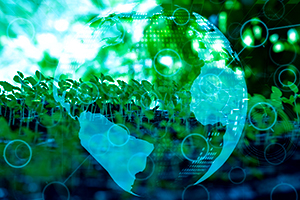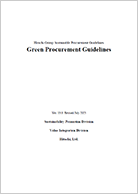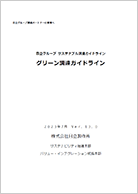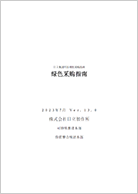Hitachi established its “Environmental Vision” to define and clarify the society which we seek from a long-term perspective, given the trend of deepening environmental issues in the world and its management policy. To realize “Decarbonization”, “Circular Economy”, and “Nature Positive” which are set forth by its Environmental Vision, Hitachi formulated long-term environmental targets called “Hitachi Environmental Innovation 2050”.
Carbon neutrality
at factories and offices
FY2030
Reduce GHG emission
by 52% through the value chain
FY2030
Achieve net zero
by FY2050
FY2050
SAQ completed
by procurement partners
approx.
3,000
companies
(FY 2023)
Hitachi has set out targets to achieve decarbonization throughout its value chain by FY2050 among “Hitachi Environmental Innovation 2050”

Among our long-term environmental targets “Hitachi Environmental Innovation 2050”, we have set a goal of achieving carbon neutrality by FY2030 at our factories and offices.
To achieve this goal, we promote initiatives with a roadmap to reduce CO2 emissions by 50% from the base year in FY2024, 80% in FY2027, and carbon neutrality in FY2030.
As specific measures, we strive to achieve the followings, with particular emphasis on increasing power sources with additionality*1:

Among our long-term environmental targets “Hitachi Environmental Innovation 2050”, we have set a goal of achieving net zero by FY2050 and reducing GHG emissions by 52% through the value chain by FY2030 (compared to FY2022)
Hitachi is supported by procurement partners which establish and maintain our value chain in wide business areas. It is important for Hitachi to have support from procurement partners and liaise with them to achieve the carbon neutrality through the value chain.
Our initiatives to reduce the upstream CO2 emissions in the value chain include Scope 3 Category 1*3 with the effort of procurement partners. In FY2021, Hitachi Group Sustainable Procurement Guidelines *4 were distributed to all procurement partners to raise awareness and promote understanding. Also, we requested our procurement partners to measure GHG emissions, set and disclose a GHG reduction goal and promote initiatives to minimize GHG emissions.
In order to calculate CO2 emission of Scope 3 Category 1, Purchased Goods and Services, in the value chain upstream, we use the spend basis method to cover entire group procurement activities and also reflect the primary data obtained from procurement partners into the calculation in part. We ensure that the primary data collection from procurement partners are through our engagement and utilize a third-party sustainability evaluation platform, EcoVadis.
We are also promoting collaboration with procurement partners to reduce Scope 3 Category 1. We selected 21 companies as environmental advanced partners in FY2022. We held discussions with these partners regarding CO2 reduction and calculation methods, information collection and analysis methods, and how to use such methods. Making use of this knowledge and methods, we expanded our target to approximately 100 companies in FY2023 to promote reduction activities. We will analyze the information on CO2 reduction measures and calculation methods obtained from the discussions with environmental advanced partners and utilize it for future CO2 reduction activities in the upstream value chain.
In addition, all new aluminum ingots (AL≥99.7%, standard block) procured for domestic use in Japan beginning in FY2023 will be, in principle, manufactured using hydroelectric power generation to contribute to reduced CO2 emissions. In this way, we incorporate and give consideration to environmentally friendly procurement, including product materials that utilize renewable energy, new technologies, and recycled materials.
As part of the Hitachi Group's Green Procurement*1 initiative, we explicitly formulate our ideas and requests regarding environmentally friendly businesses and share them with procurement partners. In 1998, the Hitachi Group was at the forefront of the industry by formulating its original Green Procurement Guidelines, in which we compiled our fundamental policy regarding the procurement of environmentally friendly parts and products, and by working with our procurement partners in accordance with this policy. In 2021, Hitachi Group revised the Green Procurement Guidelines along with the Hitachi Group Sustainable Procurement Guidelines.
In the Green Procurement initiative, we request our procurement partners to comply with the Guidelines and deliver items relating to the partners' environmental preservation activities (such as establishing an environmental management system and obtaining recommended certifications). In addition, we strive to procure items that have a reduced burden on the environment, for example, items that demonstrate (or are produced by using) the best practices for saving resources, saving energy, recycling, and properly managing the chemical substances in products and providing adequate information.
The Guidelines are available in three languages: Japanese, English and Chinese.



Please enter the Portal of Green Procurements for details on chemical substances contained in products.
For the purpose of risk management and engagement with procurement partners, Hitachi evaluates and analyzes the state of sustainability initiatives at procurement partners.
Starting in FY2022, we adopted the EcoVadis third-party evaluation platform for monitoring and evaluating the sustainability performance of our procurement partners. We perform assessments regarding procurement partners who represent a large portion of our procurement and who are important to our business strategy. We confirm sustainability efforts based on a checklist covering four areas: environment, labor and human rights, ethics, and sustainable procurement. In FY2023, we conducted sustainability assessments of approximately 3,000 procurement partners (in 58 countries) across the Hitachi Group.
We use the information obtained from these evaluations to identify companies requiring corrective action, to discuss
and monitor improvement methods, and to select and conduct sustainability audits. We will continue to work with more procurement partners and expand the number of our partners evaluated by EcoVadis assessment.
We selected 21 companies as environmental advanced partners in FY2022. We held discussions with these partners regarding CO2 reduction and calculation methods, information collection and analysis methods, and how to use such methods. Making use of this knowledge and methods, we expanded our target to approximately 100 companies in FY2023 to promote reduction activities.
We held discussions with these Environmental Advanced Partners regarding CO2 emissions reductions over a period of several months to establish an understanding of CO2 reduction measures and calculation methods. Information obtained through these dialogues will be analyzed and used for future CO2 reduction activities.
In addition, discussions with procurement partners to reduce CO2 emissions in FY2024 will be expanded in scale and continued.
We held sustainable procurement seminars in an effort to deepen procurement partners' understanding of Hitachi policies and the importance of sustainability.
We invite our procurement partners in Southeast Asia, China, and India to the Regional Sustainability Procurement Seminar to address social issues proactively together with our procurement partners.
Approximately 270 procurement partners participated in the FY2023 seminar. We strive to communicate the Hitachi Group Sustainable Procurement Policy to each region.